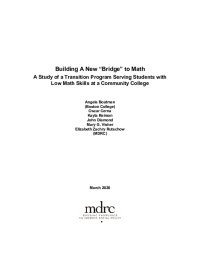Building A New “Bridge” to Math
A Study of a Transition Program Serving Students with Low Math Skills at a Community College

Most students in the United States who enter community college with limited basic math skills face substantial challenges in completing their math requirements. Many of those students — who, by and large, must begin their studies with developmental (remedial) courses — drop out before ever becoming qualified to take college-level math courses.
In 2014 the Texas Higher Education Coordinating Board (THECB) implemented major new guidelines in how students who score very low in their course placement exams should be placed and served in community college courses. After adopting a new placement test, the state raised the cut score for requiring students to enroll in developmental education and eliminated the lowest-level developmental math course. Colleges were then permitted to choose among several alternatives for serving the lowest-scoring students, who would otherwise have enrolled in the course that had been eliminated.
MDRC partnered with THECB to examine how colleges implemented the new state guidelines for supporting students scoring below ninth-grade proficiency in math on their course placement exams. This report presents the findings from a study of a four-week “Bridge Math” course at Houston Community College (HCC), which was offered for students who scored between the fourth- and eighth-grade levels of math proficiency. This Bridge Math course was intended to boost their basic skills in math in order to prepare them to tackle courses at the ninth-grade level — the level at which they could eventually enroll in developmental math.
Starting in fall 2015, students who completed the four-week Bridge Math course had the opportunity to immediately enroll in the first course of the developmental math sequence to work toward raising their skills to twelfth-grade proficiency. The data and evidence suggest that although some students who enrolled in the four-week Bridge course gained the math skills to prepare themselves for the developmental-level math sequence, the majority of those students who were referred to the Bridge course did not enroll in it, and most who did enroll did not complete it or move on to a developmental-level course.
Colleges that introduce new programs and courses often require more time than expected to fully implement them. As found in the field research for this study, students, instructors, and advisors were not uniformly aware of the new placement policies and program changes, which contributed to lower-than-expected enrollment rates in the Bridge course and still lower transition rates to the developmental course for those who passed the Bridge course. Clear vertical and lateral communication among the administration, advisors, instructors, and students — as well as through information provided on HCC’s website and social media outlets — is particularly critical when a major change in placement rules such as this one occurs, affecting so many incoming students’ chances at making it to and through developmental math and on to earning their college credential.






